 Science
in Christian Perspective
Science
in Christian Perspective Science
in Christian Perspective
Science
in Christian Perspective
From: JASA 19
(September 1967):
105-111
"The conflict between the Creation account in Genesis and Science does not cease to inspire in earnest Christians a desire to harmonize the two."1
1. A Christian anthropologist can neither ignore Biblical evidence nor fossil (scientific) evidence in his research on classification and change in man, and in his attempt to harmonize Genesis and Science.
2. Genesis gives no details about earliest man or his biology. Genesis states that man was created in Gods image. Nor is the Bible clear in stating that Adam was the first man. In fact, the name "Adam" first appears in Genesis 2:19, after the creation of "male and female" in Genesis 1:27.
3. The scientific classification of man has been largely based upon structure with change accounted for in time. If stress were placed upon culture-man as a symbol making creature-one might better define man as: where there is culture there is man, Homo sapiens, no matter the structure of a fossil.
4. The Bible is the record of man's Spiritual history. Adam is important only as he relates to Christ-the last Adam. Adam is not the first biological man. He is the first man carrying Gods promise to the world.
5. God is not contradicted in either of His expressions: in man or in nature. Hence a harmony
may be worked out if not prevented by our traditional interpretations.
*George R. Horner is Professor in the Department of Anthropology and Sociology at Eastern Nazarene College, Wollaston
Park, Quincy, Mass. Paper presented at the 21st annual convention of the American Scientific Affiliation, North Park College, Chicago, Illinois, August 1966.
I A Statement
Any Bible believing, evangelical, Christian scholar
can concur with the above statement as a desirable and
even necessary goal toward which to work. I would
add, however, if the evangelical scholar is forced to
account for the process of biological change only in
the manner set forth in the first two chapters of Genesis, along carefully delineated party lines and/or if the
earnest Christian scholar must sign doctrinal statements of faith relating to Genesis which precludes
alternative interpretations of these chapters, forcing
a scholar into a Galileo-like impasse, harmony between
the Creation account in Genesis and Science will not
only fail to be achieved, but there will be a perpetual
conflict between the two: ad infinitum., ad nauseum,
amen.
The questions to which this paper will address itself are: 1) Can there be a harmony between Science and the Bible? 2) What are the implications of classification vs process? 3) The relation of the above to problems of classification and the process of change in man.
II The Setting for the ConflictFrom Aristotle to Hume it was assumed that Truth is of one kind and that the validity of statements about God can be tested by the same criteria that might also apply to angels, dogs, cats, art, beauty, society and man. From Hume to the present, validity about God and validity about man are achieved by two different propositions: the Truth of Dogma, I believe" and truth arrived at through empirical methods: the Truth of Science.
This dichotomy has resulted in the so-called incompatibility of Science and the Bible. The Scientist and the Christian scholar seem to view reality through two different frames of reference. The Scientist, limited by his senses or extension of same, does not find God necessary in interpreting nature; the Christian scholar cannot interpret nature without God. Hence a conflict.
The Christian man of science cannot deny the evidence (facts) discovered by science-a fossilized human skull-any more than he can repudiate his belief in a God who has revealed Himself, no matter how imperfectly, both in nature and in the Bible. By repudiating, or not admitting God, the Scientist reduces nature and man to material, with process mechanically motivated.
During the past twenty-five years, Christian scholars have divided themselves into two polar positions. (This does not deny a third possible position.)
1. The anti-evolutionists have a long history in evangelical circles. The names of those belonging to this group are too well-known to have to be listed in this paper. To members of the group "evolution" has anti-Biblical connotations. The goal for this group is to disprove evolution-period.
2. The pro-evolutionists are a more recent phenomena, appearing on the scene during the past ten to fifteen years. They, at first glance, seem to have capitulated to the evolutionists. The group has accepted the fact (whatever that means) of evolution. They are evolutionists as scientists but evangelical and/or fundamental in their Christian beliefs. The group is also too well-known to list names.
Note that in both instances the magnetism of evolution, negatively and positively has drawn Christian scholars into the vortex of its influence.
III Some Modem Meanings of EvolutionThe fact that one can talk about "meanings" of evolution, let alone modem meanings, suggests the lack of specificity in the meaning of the word itself. It is a word of many different meanings. It is an abstraction. Darwin started with this abstraction in order to describe a process (Linneaus in the 1730's bad set up the classification) of how new forms emerged from a continuity of change by means of natural selection. The word evolution has become a convenient catchword to describe any kind of change.
In order to have a reference point, I would like to use the following definition of evolution, one which will be understood as what I mean when I use that word: "Evolution is the gradual development from simple, unorganized condition of primal matter to the complex structure of the physical universe; and in like manner, from the beginning of organic life on this planet, a gradual unfolding and branching into varied living forms which constitute the animal and plant kingdoms."2 The first is called inorganic evolution, the second, organic evolution. We shall be concerned with the latter.
It is apparent, from this definition that change is basic, is the "fact" of evolution. However, the kind of change and the method or process of change is not so evident and remains a major housekeeping problem among the evolutionary theorists. Further, just because evolution is change does it necessarily follow that all change is evolution?
There are three kinds of organic change defined as "evolutionary". These are: 1) Speciation, 2) Phyletic and 3) Quantum.3
1. Speciation. This is easily demonstrated and understood by all. The differences noted between, for example, kittens, having the same parents, or between varieties of roses, are speciation differences. Speciation is the dynamic of change, of evolution. Speciation prevents sameness, it prevents two living organisms from being exactly the same as their parents or each other. This kind of change is called evolution.
2. Phyletic. This kind of change may occur within groups larger than the above, but within phylla, or genetically defined families; for example, changes in the horse series. This kind of change is also called evolution.
3. Quantum. This kind of change implies a probable process such as "jumping gaps," leaping over families, phylla, orders or classes.4 This kind of change has not been demonstrated; it is only theoretically possible. This kind of change is also called evolution.
For purposes of clarification and to be strictly accurate (scientific?), I would call both speciation and phyletic change developmental rather than evolutionary, since only degrees of change are involved. I would reserve quantum change as true to the intent and the definition, given above, of evolution.
IV The Classification of Man and Scientific EvidenceMan is classified as a primate because he shares with other members of this Order-the Chimpanzee, Gorilla, OrangUtan and Gibbon-biological similarities. To a lesser degree, he likewise shares with them certain physiological and psychological characteristics. Man and other creatures of this Order, for example, have approximately the same number and kinds of bones. Similar emotional and psychological responses are also shared such as anger. Such similarities are too well recognized to give further attention to in this paper.
Man is classified as Homo sapiens, not upon great structural differences but upon relatively small differences which, to paraphrase Shakespeare's Alrs Well That Ends Well, "make (for) differences so mighty." These small differences are found primarily in the skull, cerebrum, and to a lesser extent, in the skeleton. Space permits only one example from each of the above.
1. Skull. Two-thirds of man's skull is brain area. In contrast, two-thirds of the gorilla's skull is face area. One-third of man's skull is face area while one-third of the ape's skull area is brain.
2. Cerebrum. The cerebral difference is the presence of a large area of association in the rear of man's brain. It is practically absent in the ape. The presence in man of a well developed frontal area, an area where man controls his temperament and emotions of the more sophisticated variety, is lacking in the ape, and the area of speech is likewise absent in the apes.
3. Skeleton. One noteworthy anatomical difference is readily observed in the up-rightness of man's stature, a result of a four curved vertebral column as opposed to the single curve of the apes. This prevents the apes to naturally and habitually stand and walk while erect.
MODELS SHOWING THE INFERRED PHYLOGENETIC
RELATIONS OF MAN TO THE PRIMATES
Figure I
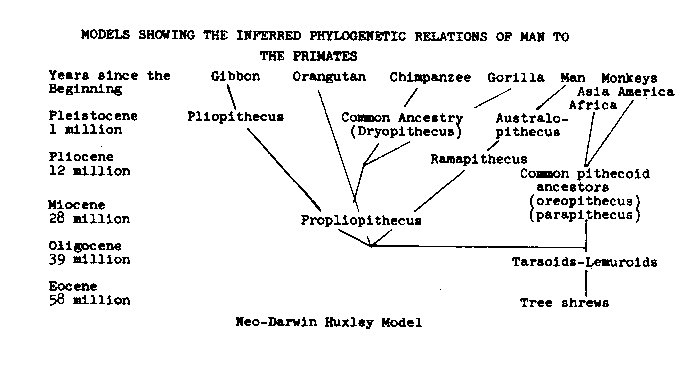
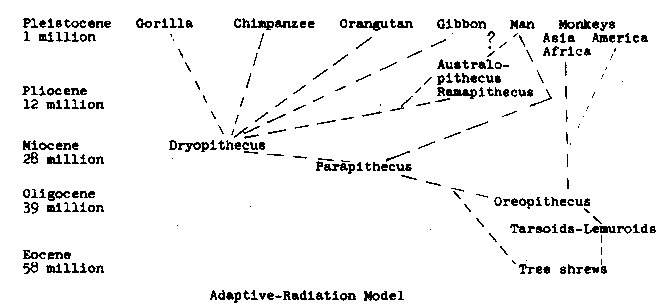
Very few argue about man's biology or his classification. "There is nothing unique about the animalness of man".5 How did man become unique? In what way is man unique? What process was (is) involved? Here is where the Christian scholar of science faces his difficulties and differences and the basis for differences for all interpretations.
V Two Modem Evolutionary ModelsThe two modem evolutionary models are illustrated in Figures 1 and 2. These may also be considered as classifications of man, for man is classified with others of his order.6
But more than a classification, both models imply process, an interpretation of change, illustrating the direction and the results of change leading to man. Both models assume that this change took place in the five epochs of the Cenozoic area, with man most likely first appearing in the late Pliocene, (3-5 million years ago), if the discovery of Homo habilis and its interpretation by its discoverer, Leakey, is confirmed. Both models start with the tree shrew although the tarsier is considered as more ancestral to man.
Despite using the same facts, these are two conceptually different models. One (Figure 1) relies upon Darwin's concept of natural selection as the dynamic of processual change, with change oriented in a given direction. Darwin's original concept was modified by Huxley and today is the model of the neo-Darwinists.
The second model stresses random and fortuitous change through chance-environmental adaptation on a natural selection base as the process of evolution leading to man. This model is named the "Adaptive-Radiationist."7
These models also differ in that the Darwin-Huxley model theorizes that both modem apes and modem man bad an ape ancestor (Dryopithecus) in common, preserving Darwin's original idea but with a difference. The adaptive radiationist model theorizes that apes and man had a common ancestor which is a now extinct monkey-tarsier type (parapithecus). Incidently, the tarsier is a little four inch tall, round headed, Mickey Mouse looking animal with pop eyes, big ears and can pivot his head in an almost complete half-circle.
A growing group of modern anthropologists favor the Boule-Straus model which we shall consider next.
VI Fossil Evidence, Evolutionary Models, and Factors Necessary to Interpret ProcessFigure 3 shows some of the fossil evidence defined as man, where these fossils lived upon the earth and their approximate date. There is no doubt as to the veracity of these facts. Upon this evidence all interpretations must be made whether one is a non-Christian scholar, a Christian scholar or variations of any of the above.
Evidence is interpreted according to one's conceptual model; one's frame of reference. Figures I and 2 are two such models. With illustrations taken from the fossil evidence of man, I will demonstrate how one can arrive at two different interpretations using the same evidence.
1. The Darwin-Huxley model. This model classifies man as a primate and adding process to the model, it would appear that a miscarriage by an ape brought forth man, or more technically, a mutation. Evidences for this are the fossil apes found in Asia, Gigantopithecus, and Africa, Australopithecus, both considered as ancestral to modem man. These man-like apes, homi-
Figure 4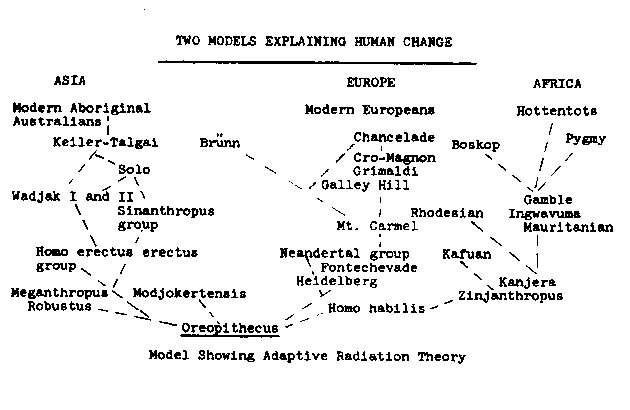
noids, gradually became ape-like men, hominids, so called because of ape-like facial and skull features, the supra-orbital ridge across the eyebrow and the keel growth around the skull. This is well illustrated in all anthropological text books. Those usually listed include: robustus and meganthropus of Asia (Java); the Heidelberg man (jaw) of Europe; Homo habilis and Zinjanthropus of Africa.
Through time, the hominids gradually changed, through the process of natural selection, until the first Homo sapiens appeared some 93,000 years ago: Wadjak I and 11 and the Solo River man of Asia (Java); Cro-Magnon and others in Europe and Gamble man in Africa as seen in Figure 5.
2. The Adaptive-Radiationist model. Here, too, man is classified as a primate. Interpretation of process (see Figures 3 and 4) demand parallel and random change; no direct lines between any two groups are theoretically possible and many, many missing links are implied.
Gigantopithecus and Australopithecus are not even theoretically useful in this model and theory since according to it, man lacked an ape ancestry. The model begins with robustus in Asia, Heidelbergenesis in Europe, and Homo habilis and Zinianthropus in Africa. In short, this theory begins with the hominids or man. Man by-passed the ape stage in this model! To this group the hominids are not ape-like men. They are men with reservations, that is, different degrees of man. Homo sapiens appear randomly as opportunity and environment permits and often contemporary with the hominids, rather than at the end of a long process of natural selection according to the Darwin-Huxley model. Evidence for these racial mixtures and mixed populations living together can be observed in the Mt. Carmel eaves where Homo sapiens were contemporary with the Neandertals. This is not an isolated example. It is also true of the Pekin (Choukoutien) skeletal material.
Factors. Both models are based upon a single facto or or variable for its interpretation: the biological factor of anatomical structure. Although the factors of geography and strata (time) are noted, these do not carry the interpretive weight implied in them. Four factors should be included in the intepretation of any and all
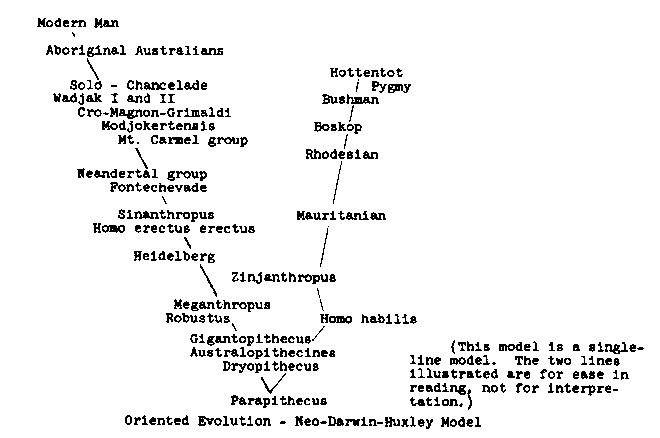
Figure 5
skeletal remains (wherever possible): 1) structure, 2) geography, 3) strata, and 4) culture.
I should like now to illustrate the importance of factors other than the biological.
1. Geography. Figure 3 shows when and where human fossils have been found with the process of human change going on simultaneously in Europe, Asia and Africa. This point is not brought out in using only the biological factor since the sequence in structure is most important. The question to be faced here is: Did man originate independently in three world areas or did he originate in one area and migrate? Evidence for the earliest human is found in Africa, Homo habilis, tentatively dated as 3 million years old. The evidence of geography argues for the possibility of polyphyletic origins of man.*
2. Time. The factor of time shows that there was not a neat sequence of bodily change from the so-called ape-like man to modern man according to the DarwinHuxley model. Rather, there were mixed populations living both together and contemporary; and according to the evidence of the Neandertals, the preMousterian (a cultural period in the old stone age when man used mainly axe-like tools) Neandertals were Homo sapiens while the later Mousterdian Neandertals were structurally "ape-like."
3. Culture. Only man is a culture or symbol making creature. Hence wherever culture is found, there is man. A stone accidently shaped or used by either man or ape, is not evidence of culture. A stone purpositively shaped and used and the knowledge acquired in the manufacture of such an axe, taught and passed down to succeeding generations, is primary evidence of culture and man.
For example, Zinjanthropus living almost two million years ago in Africa though biologically ape-like, yet as a culture producer, was a rational human being, a Homo sapiens.
* A monophyletic origin of man could be argued on the basis of blood types. 1. Blood type "0" is considered as the oldest (first?) since it will mix with all other types in transfusions. 2. Blood types "0" and "A" are found in a world-wide distribution, implying a common blood-type base, a common origin. Applying the Sewell Wright Effect in genetic drift, new types emerged from the ancestral types "0" and "A" as populations migrated farther apart in time.
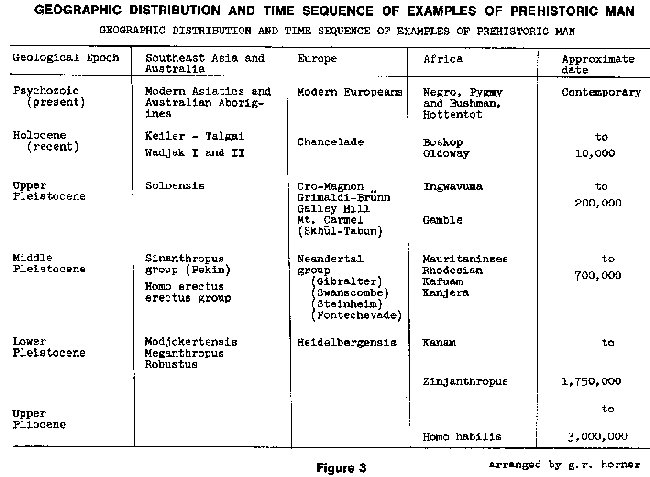
Culture ought to have the greatest weight in interpretation since culture associated
with
fossil evidence,
identifies material as human despite structural appearance. Of the fossil evidence listed in Figure 3, cultural
remains have been found in all but six. These are: robustus, meganthropus,
Heidelbergensis, Pithecan thropus erectus, the first Sinanthropus (Choukoutien
and modiokertensis. Of this group, the last three are
biologically identified as human, while the remainingare described human on scanty osseous evidence.
Culture, it seems to me would change much of the interpretation of fossil remains of man since, of those
listed, the great majority are culture makers. There is
evidence of Homo sapiens from the first men as science
defines it.
Modem pygmies of Africa and the Philippines and
the Arunta of Australia are biologically "neandertaloid."
Both have bony eye-ridges, broad noses and long, narrow head, yet no one questions their humanness or
that they are Homo sapiens. They appear to be
living descendents of man's earliest ancestors.
VII Process
Because of the
emphasis that the Darwin-Huxley
model places on morphology, it is unsatisfactory as a
model to interpret human change.
The adaptive radiationist model, although there are
some still unanswerable questions implied in it, gives the best interpretive results, considering all of the fac tors involved, but particularly, in that the appearance of
- varieties (speciation) of man is based upon fortuitous combinations of genes. This model implies that there
has been one kind of man, though differing in degree, throughout history. It further starts with man, but
allows for different explanations for man's origin(s). Of the three types of evolution described earlier in the
paper, the second model implies both speciation and phyletic change process, rather than quantum evo lution as the interpretive basis for man's change as in the Darwin-Huxley model. Man has developed rather than evolved. Kraus, in his book, The Basis of Human
Evolution (and almost contradicting the title of his
book) makes the point very succinctly: "Invariably the question arises could a pithecanthropus child,
born and raised in the modem world, have developed into
an efficient member of society? My (Kraus) sugges tion is that he would have fared no better or no worse than a randomly selected infant bom of Homo sapiens."8
VII Sundry Conclusions
A Christian scholar can neither ignore fossil or cultural evidence, nor can he ignore the Bible. His goal is to harmonize the evidence found in the Bible with the evidence in Nature as they relate to the total 11 phenomena of man," to borrow from Chardin, as the basis for objective, truthful, scientific conclusions.
A scholar must face the fact that Genesis does not give many details about the biology of earliest man, or the earliest date of man; or where he was first created -or if there were many "Adams and Eves; " or if there was just one original pair.
Specifically, the Bible is very clear and to the point that man was created in God's image. We do not yet know what this fully means. Was it a miracle or a process? But how? Was the "soul" as God's image created ex nihilo or was a soul "Planted" in a creature, say a humanoid? Were there a pair of these humanoids from which all men are descended? Was the imputation of a soul racially or multi-racially in one or more continents at approximately or exactly the same time in many groups. One point we are sure, like his Creator, man can create. It would seem that man's biological structure has little relationship here. Man is a rational, symbol making creature.
Perhaps scholars, both non-Christian and Christian, have spent too much time disputing the meanings of man's morpobological structure. The Bible relegates man's body to dust. It is the soul (God's image) which is unique in man, rather than the body.
Unless one pushes "Adam" back further and further in Time, each "time" changing with fresh discoveries, which is theoretically possible, it would appear that the first man (Adam) mentioned in the Scripture is perhaps best considered as our Spiritual First Ancestor, rather than our biological first ancestor. (Recall that the children of Adam and Eve found mates whom they could marry who weren't necessarily related to them.) The Bible is a record of man's Spiritual history, from Adam to Christ, rather than his biological development. I mentioned a third group of Christian scholars in my opening remarks. This third group, of which I am a member, are the Neo-creationists. This group can be described as: non (quantum) evolutionary but certainly phyletic and speciational evolutionist! Creationist in- the particular sense that the implanting of a soul, and symbol making capabilities in man, was a miracle,
creative act. This is the point of difference. It is the point which must be and can be maintained by those who wish to harmonize the Bible with human development.9,10
1.Millard, Alan. Book review of Creation Revealed Christianity Today, Vol. VIII, No. 15, April 24, 1965: p. 32.
2. Lull, R. Organic Evolution, 1938, p. 6.
3. Simpson, G. "Tempo and Mode in Evolution," 1944, p. 202.
4. Simpson, G. Ibid, p. 206.
5. Homer, G. "Letters to the Editor," Christianity Today, July
2, 1965, p. 14.
6. Hoebel, E. Man in the Primitive World, Rev. ed. 1964,
pp. 39-40.
7.Straus, F. "The Riddle of Man's Ancestry," Quarterly
Review of Biology, Vol. 24, 1949, pp. 200-203. Note: see
also Kraus, B. The Basis of Human Evolution, 1964, pp.
29-32 for five similar models constructed by other investigators. Also BouIe, M. Les hommes fossiles, 1921.
8. Kraus, B. The Basis of Human Evolution, 1964, p. 282.
9. Homer, G. "Science That is Scientific," His, Nov. 1947.
This is a discussion of my earlier "non-evolutionary" position, changed in this paper. Also, Homer, "A Christian
Evaluation of Physical Anthropology," Modem Science and
the Christian Faith, Ist ed. 1948, pp. 197-232.
10. Buswell, J. 0. 111, "A Creationist Interpretation of Prehistoric Man," Evolution and Christian Thought Today
Mixter, ed. 2nd ed. 1960, pp. 165-189.